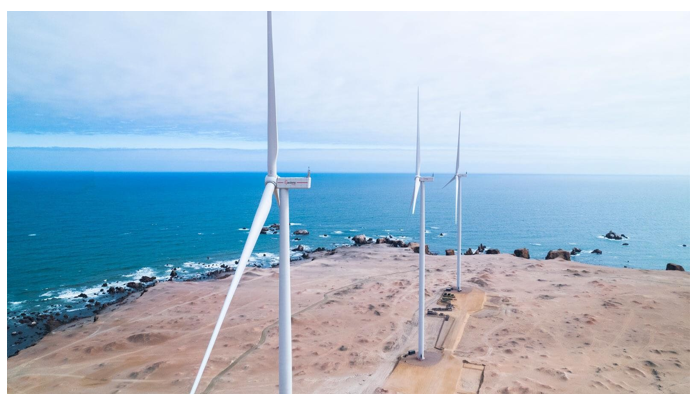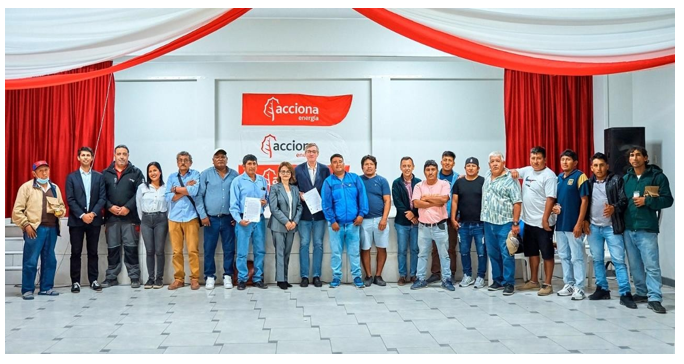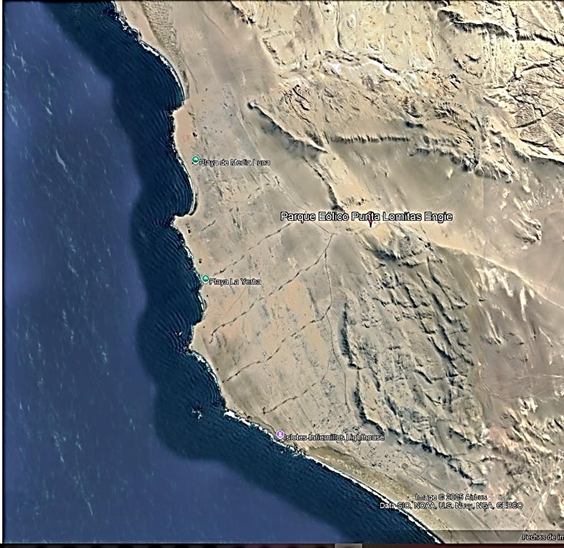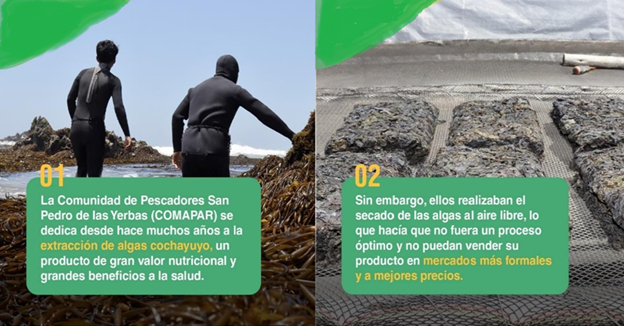MOJ
eISSN: 2573-2919


Research Article Volume 10 Issue 3
Escuela Universitaria de Posgrado – UNFV, Perú
Correspondence: Eduardo Martin Villalobos Porras, Escuela Universitaria de Posgrado – UNFV, Jr. Camaná 1014, Lima, Perú, Tel 51-992776727
Received: April 30, 2025 | Published: May 21, 2025
Citation: Villalobos EM. Vento’s corporate social responsibility and its contributions to the sustainability of artisanal fishing activities in Southern Perú. MOJ Eco Environ Sci. 2025;10(3):99-104. DOI: 10.15406/mojes.2025.10.00352
This article, based on a qualitative study, analyzes the relationship that has developed in recent years and will continue to be presented in the future between the implementation of wind farms and artisanal fishing activity in southern Peru, specifically in the districts of Marcona and Ocucaje. It uses as secondary sources of information studies and implementation reports on corporate social responsibility from wind energy companies in Marcona and other parts of the world. It also uses as a primary source an interview with a representative of a wind energy company already in the operating phase of a wind farm in the district of Ocucaje. The aim is to investigate the progress that wind energy companies are making in their Corporate Social Responsibility in supporting local development, specifically their support for sustainable artisanal fishing in the districts of Marcona and Ocucaje. It then prospectively proposes some alternatives and strategies that will help increasingly promote sustainable artisanal fishing in southern Peru.
Keywords: wind farms, local development, onshore wind energy, corporate social responsibility, sustainable artisanal fishing
Wind energy is a type of non-conventional renewable energy that is obtained from the wind using its kinetic energy, transforming it into mechanical or electrical energy through machines composed of oblique blades joined by a rotating shaft, called wind turbines, which are responsible for transforming wind energy into electricity.1
In this regard,1 points out that wind energy generates certain benefits to society and the environment (pp. 237 and 238) because: It lowers social conflict, Decentralises electricity generation, reduces levels of environmental pollution, and because they are quick to implement compared to conventional power plants.
Therefore, the joint installation of wind turbines connected to supply networks is called a wind farm, for wind farms installed on land it is called ‘Onshore’ while for wind farms installed at sea it is called ‘Offshore’.1 In the Peruvian case, onshore wind farms have been planned, built and operated in recent years, mainly in the districts of Marcona and Ocucaje.
As a theoretical concept, the concept of ‘corporate social responsibility’ (hereinafter CSR) coined by Barroso2 will be used for this research, referring to the active and voluntary contribution of companies to social, economic and environmental improvement, through a set of practices, strategies and business management systems that pursue a new balance between economic, social and environmental dimensions at the local level. (p.76).
Complementarily, CSR will be dealt with under the vision of Quispe et al.,3 understanding the responsibility that every company has with society to generate an environmental accounting that favours the economic growth of the company, as well as the welfare of society (p.104); and under the proposal of Villalobos et al.,4 referring that CSR of companies located in coastal areas should promote the local economic development of artisanal fishermen in the Peruvian coast (p.73).
Finally, the other concept that will be used in this article is that of ‘sustainability of artisanal fisheries’, meaning small-scale fishing that generates social, economic and environmental benefits, related to protecting marine fauna, avoiding food waste, contributing to food security, generating jobs, reducing pollution by generating less waste, minimising energy consumption and reducing the use of chemicals that damage the ozone layer.5
The article has been organised in three sections. Section 3.1 describes the context of the increase and implementation of wind farms in southern Peru as a result of the change in the Peruvian energy matrix; Section 3. 2, analyses the progress and contributions of Corporate Social Responsibility (CSR) of wind energy companies in southern Peru in terms of their support for local development, specifically the sustainability of artisanal fishing in the districts of Ocucaje and Marcona, and compares it with other international cases of interaction between wind farms and populations and their social contributions through their CSR; finally, section 4. 1 discusses and proposes, from a prospective approach, alternatives and strategies to help promote the sustainability of small-scale fishing in the south of Peru from the perspective of corporate social responsibility, which is already being carried out by wind energy companies.
Objective
In this sense, the general objective of the research in this article is to carry out a brief analysis of the interaction that has been taking place in recent years and will continue to occur in the future between the implementation of wind farms and artisanal fishing activity in the districts of Marcona and Ocucaje, as part of the change in the national energy matrix to obtain clean energy to feed the National Interconnected Electrical System of Peru (SEIN); the specific objectives being:
The research design is exploratory and descriptive for a given period of time (2016 to 2024). This research design was chosen because wind energy activity is relatively new in Peru, and therefore, so is its interaction with artisanal fishermen in coastal areas of southern Peru. In this sense, in this research, the analysis and review of secondary sources such as studies and reports on the execution of corporate social responsibility of wind energy companies in other parts of the world and in Marcona is carried out, and methodologically combined with a qualitative study carried out through a semi-structured1 interview with a representative of a wind energy company that is already in the operation stage of the wind farm. In this respect, it should be clarified and specified that, for the purposes of this article, given its relevance to the research, the interviewee was anonymised.
1This technique is applied by means of a semi-structured agenda, elaborated on the basis of the defined objectives. In this way, it is possible to access deep levels of information, beliefs and perceptions of the interviewee, regarding the objectives of the study, among other important topics such as productive activities.
Increase and commissioning of wind farms in the south of Peru
Gamio6 quotes the Ministry of Energy and Mines et al.7 stating that the 2008 wind map has shown the great wind potential of the country, especially on the coast with 22,500 MW of usable power, where it is common to find areas with wind speeds greater than 5 m/s, i.e. the minimum speed to consider economically feasible the generation of electricity from this resource (p. 105).
Subsequently, Vásquez and Gamio,8 then reiterate that Peru has great wind resource potential, since on average wind speeds of between 8 and 11 m/sec are obtained, especially in coastal areas with wind speeds above 5 m/sec (p. 105).
In this sense, Vásquez and Gamio8 reflect and conclude that Peru has great energy potential to develop alternative renewable energies; the idea is to achieve an electricity matrix with an 80% share of renewable energies, paving the way to be closer to 100% of the electricity matrix based on renewable energies by 2050 (pp. 214, 215 and 218).8
In this line, in relation to the gradual change of the energy matrix in Peru, in recent years (2016 to 2024), the construction and operation of wind farms in the department of Ica has been increasing, mainly in coastal desert locations and coastal areas, in view of the great opportunity to achieve wind speeds that can be reached in those places, especially in the districts of Marcona and Ocucaje, belonging to the department of Ica. In this sense, the following wind farms are already operating in the district of Marcona: Wayra I Wind Farm, Wayra Extension Wind Farm, Marcona Wind Farm and Tres Hermanas Wind Farm, while in the district of Ocucaje, the recently opened Punta Lomitas Wind Farm is already operating. A brief description of each wind farm mentioned above is given below in chronological order:
Progress and contributions of Corporate Social Responsibility of wind energy companies in southern Peru
At a global level, in several countries, the contributions of Corporate Social Responsibility (hereinafter CSR) of wind energy companies are linked above all to providing contributions to the local development of the communities and/or social organisations considered within their area of influence, due to the impacts that their implementation will have on them at different stages, especially in the construction and operation stage.
For Medina,10 the positive impact of the implementation of wind farms on the economy and the energy transition is considerable, especially due to the creation of employment in the various stages of production, stimulating, above all, the local economy (p.205).
Mendoza et al.11 cite Guédez (2001), pointing out that companies, in this case wind farms, have the responsibility to cooperate in solving the problems that concern them as a member of the society where they operate, in a kind of ‘operating environment’, as it is impossible to abstract from the local problems with which they coexist: poverty, insecurity, health, education, culture. Under this conceptualisation, Mendoza et al.11 conclude that companies have the duty to assume responsibilities towards the society in which they are inserted, in terms of not harming the environment, but also in being generators of employment in the community, as well as contributing to cultural, educational, religious and health well-being, among other social and economic benefits (p. 444).
For Villegas,12 the CSR of wind energy companies consists of a set of mandatory duties and actions that imply a retribution from the business organisation towards society and the environment in which it operates, allowing it to positively affect the socio-environmental surroundings in which it is located.
Complementarily, CSR under the vision of Quispe et al.3 is the responsibility that every company has with society to generate an environmental accounting that favours the economic growth of the company, as well as the welfare of society (p.104).
In this line of analysis, the proposal by Villalobos et al.4 points out that the CSR of companies located in coastal areas should promote the local economic development of artisanal fishermen on the Peruvian coast (p.73).
In this sense, for the purposes of this research, wind energy corporate social responsibility is understood as the active contribution of wind energy companies to the improvement of the social, economic and environmental dimensions of their social environment in the area of influence of their project, which are mostly artisanal fishermen, Therefore, contributing to the improvement of their economy, education and health through social activities and projects, mainly aimed at contributing to the improvement of the aforementioned social indicators of human development of artisanal fishermen and other populations in the vicinity of their wind farms in Peru.
In this regard, a comparative sample of experiences at international and national level of the progress and contributions of the implementation of Corporate Social Responsibility of wind energy companies, especially in southern Peru, is presented:
Vestas
The first case is related to the Danish-based company VESTAS, which has implemented a community development programme in India, near its 250 MW wind farm in Gujarat. This programme benefits 13 villages closest to the wind farm, in Bhuj and Mandvi blocks of Kutch district, Gujarat, India. Social benefits have been directed towards supporting children's education, skills development, water and sanitation, and care of domestic animals. The community programme continues, even during the service phase of the wind farm, which has generated the following positive impacts to date13:
Iberdrola
Another case is that of the company Iberdrola, which in the Dos Arbolitos or Parques Ecológicos de México (PEM) wind farms, both located in the municipality of Juchitán de Zaragoza, Oaxaca, has developed a series of actions that seek the integral benefit of the entire community. In this sense, these residents have been receiving a monthly rent (easement) for the use of their land for more than a decade, which has resulted in a better quality of life for them and their families in general thanks to the economic benefits generated by the installation of the wind farms.14
Other support provided by Iberdrola to its stakeholders has been the construction and improvement of schools, roads and sewage systems, among others. Similarly, the company hires local professionals at the plant or as suppliers to provide services during the various stages of operation and maintenance.14
Other social programmes that Iberdrola has implemented for the benefit of its stakeholders include the ‘Luces de Esperanza’ programme, one of its most emblematic social projects, because it brings electricity to rural areas through solar systems. On the other hand, through Impulso STEM, this wind energy company has promoted and financed local people so that they can pursue scientific and technological careers, such as renewable energy engineering, among the youth of Oaxaca, especially women.14
ACCIONA Energy
In the Peruvian case, for example, the company ACCIONA Energy has implemented a social investment model called ‘Trust Funds’ for the year 2023 in the town of Marcona, aimed at the productive development of the Marcona Artisanal Fishing Community (COPMAR), neighbouring its first wind farm.15
Jesvana Pollicardo, an official of the company, explained that this collaboration model has been implemented within the framework of a relationship process that has been built with COPMAR, which represents 15 Artisanal Fishermen's Social Organisations (OSPA) located on the Marcona coastline, and which they have called ‘Trust Funds’ because it is based on a synergic work of dialogue and collaboration, around initiatives aimed at improving working conditions and enabling fishing community spaces. Along with this, the wind energy company opened a permanent information channel with leaders and partners of the OSPAS to continuously strengthen the programme.15
In this regard, in recent years, ACCIONA Energy has supported the development of 7 projects promoted by the OSPAS Jóvenes Pescadores, San Nicolás, San Pedro, Buzmar, José Olaya Balandra, Cristóbal Colón and Acumar. Among the initiatives implemented are the construction of social headquarters, improvement of some access roads to productive areas and fishing equipment (Figure 1).15

Figure 1 Wind turbines at the San Juan de Marcona wind farm near the coastal shoreline of southern Peru. Source: Acciona Energy. 2023.
In addition, on 3 May 2023, in the district of Marcona, ACCIONA Energy and the San Juan de Marcona Artisanal Fishing Community (COPMAR) signed a Voluntary Collaboration Agreement, which will benefit the 17 Artisanal Fishing Organisations (OSPAS), to promote a Development and Promotion Plan in Marcona, with the aim of helping to improve the production and working conditions of the OSPAS. This agreement will be materialised through an annual Productive Fund, which will be allocated to the execution of projects and programmes previously agreed upon by both parties.16
Moreover, as part of the signing of this agreement, ACCIONA Energy also undertook to respect access and transit within the concession area of the San Juan de Marcona wind farm, and a 200-metre strip from the sea, thereby guaranteeing the continuity of fishing activity in the area. The agreement is part of the Social Impact Management (GIS), whose purpose is to ensure that collaborative relationship processes are generated with the communities around the care and development of the activities they carry out in the territory where ACCIONA Energy develops its renewable generation projects (Figure 2).17

Figure 2 Signing of agreement between wind energy company and COPMAR. Source: Acciona Energy. May 2023.
Engie Energía Perú
Another Peruvian case is the company Engie Energía Perú, which has also been supporting the Ocucaje Fishing Community in recent years. Carlos, an official of the company, reported in an interview that the wind energy company has started the construction of the wind farm Punta Lomitas for the years 2021 and 2022. To date, the company has already been operating and producing wind energy in the area of Ocucaje for a year and a half.
With regard to Engie Energía Perú's corporate social responsibility, Carlos comments that the company supports two major social groups within the area of influence of its wind energy activity; The first group is related to farmers (located 60 kilometres from the wind turbines) and the other group is related to the artisanal fishing community located very close to the wind farm on the Media Luna, La Yerba and El Faro beaches, which has approximately 130 members, including fishermen and seaweed gatherers, organised into 10 groups of associations, of which 6 are informal and 4 are formal, with José Luis Salcedo Herrera as the representative of these associations.
In this regard, Carlos points out that by the year 2021, they identified energy shortages in the 10 fishermen's associations mentioned above, which are dedicated to fishing and seaweed harvesting.
The company helped them with the financing and installation of solar panels with batteries and refrigerators so that they can keep their perishable food and their marine resources caught, giving them the opportunity to improve their quality of life and improve their productive activity, These fishermen now have TV and cable to keep their families entertained, as well as allowing them to conserve fish for later sale in external markets, contributions that are maintained over time, given that these fishermen protect and maintain in good condition these infrastructures provided years ago by the wind energy company (Figure 3).

Figure 3 Location of Punta Lomitas Wind Farm next to Media Luna and La Yerba beaches. Source: Google Earth-2025.
In 2023, Engie Energía Perú also supported the fishing community of San Pedro de las Yerbas (COMAPAR), an association of fishermen dedicated for several years to the extraction of cochayuyo seaweed and other fishing activities, by managing and advising them to win one of the competitive funds of the National Innovation Programme for Fisheries and Aquaculture (PNIPA) of the Ministry of Production, which has led to a significant improvement in their product (PNIPA) Ministry of Production, which has greatly improved their product (drying cochayuyo seaweed) and sales conditions. Currently, Carlos points out that the company has provided these fishermen with equipment to build a chopping plant in agreement with the Scientific University of the South, to improve the drying of seaweed, with machinery so that they can chop and lay it down, so that it has an added value in the future, the only thing that remains is to look for the market, so that they can obtain more economic income than COMAPAR now receives. In this respect, Carlos points out that these improvements in the extraction and harvesting of seaweed have generated changes in the seaweed harvesters themselves, in relation to traditional artisanal fishing practices in the area, in view of the training they have received in conjunction with the Universidad Científica del Sur in relation to the harvesting, extraction and drying of cochayuyo (Figure 4).

Figure 4 Wind energy company support for improved Cochayuyo extraction.
Source. Ocucaje al día. October 2023.
Carlos, also points out that Engie Energía Perú provided other support to the fishermen in the area by hiring them as local personnel during the construction phase of the wind farm (as guards, helpers); It has also provided funding to date for a project presented to the Ministry of Production (PRODUCE), which seeks to contribute to the sustainability of Ocucaje's artisanal fishing activity, given that the area where they fish (Media Luna, La Yerba and El faro) has good benthic invertebrate resources (sea urchin, sea urchin, sea bream, octopus, octopus, etc.), The main objective is that these fishermen are vigilant of these benthic invertebrate resources, and that they achieve a sustainable extraction of this resource for the good of their families and future generations. To date, this project consists of making a baseline of benthic invertebrate resources and then obtaining a sustainable extraction plan; so far, the project has already received a favourable opinion from the Port Captaincy (DICAPI), the National Service of Natural Protected Areas (Servicio Nacional de Áreas Naturales Protegidas), and the National Institute for the Protection of Benthic Invertebrates (INAE).
National Service of Natural Protected Areas (SERNANP), the National Authority of Health and Safety in Fisheries and Aquaculture (SANIPES), among other institutions of the Peruvian State.
In this regard, Carlos says the following:
On these shores, the quantity and size of limpet and sea urchin that is extracted is impressive, and there is no policy to be able to sustain this benthic resource, these same seaweed collectors are also looking to the future, not only to collect seaweed, they are looking to preserve this resource, so that at the same time as they have the resource of seaweed, They can also maintain this important resource of benthic invertebrates, creating a kind of symbiosis, so that both resources are taken care of, in the style of the fishing communities of Marcona, but with the issue of the benthic resource, so that these same associations can be vigilant of this benthic resource and at the same time they can collect their algae, thus helping to generate a sustainable extraction and protection of these resources.
Some proposals for supporting the sustainability of artisanal fisheries through the CSR of wind power companies
Based on this brief description of the implementation of CSR by wind energy companies at both the international and national level (implemented in the districts of Marcona and Ocucaje), it is clear that in the case of wind energy companies whose onshore wind farms are located in coastal areas, the implementation of their CSR will mainly be channeled with artisanal fishing organizations, of course, if they exist in the area of influence of the wind energy project.
In this sense, and without being limiting, there are four important lines of action to consider for the implementation of the CSR of wind energy companies to promote the sustainability of artisanal fisheries in their area of influence:
Corporate Social Responsibility (CSR) of Onshore wind power companies located in coastal areas, especially in southern Peru, has been increasingly implemented and developed in recent years as a result of the change in the energy matrix in Peru, which implies the active contribution of these wind power companies in improving the social, economic and environmental dimensions of the social environment of the area of influence of the wind power project, These are mostly made up of organizations of artisanal fishermen, thus contributing to the improvement of their economy, education and health through sustainable social fishing projects, mainly aimed at contributing to the improvement of the aforementioned social indicators of human development of artisanal fishermen and other populations neighboring their wind farms in southern Peru.
These social fishing projects can be replicated in the future by other wind energy companies located or to be located in coastal areas of Peru, taking as an immediate example, what has been done from the CSR of wind energy companies in southern Peru, regarding their support to artisanal fishermen in the districts of Marcona and Ocucaje, and also raised in a more diversified way in the item “3.3. “In this article, social fishing projects that should be directed through the CSR of Onshore wind energy companies located in coastal areas, in order to contribute to solve the main social and economic problems of local artisanal fishermen located in the area of influence of wind energy activity, This, of course, from a vision of sustainability, in order to allow the artisanal fishing communities to conserve the local environment, improve their productivity and economy, and to rationalize the extraction of marine resources in a responsible manner, with the quality of life of future generations in mind.
To my wife Giannina and my daughter Regina for their patience, encouragement, affection, love and understanding during the preparation of this article.
Author's contribution
Eduardo Villalobos Porras: conceptualization, initial drafting, research, final drafting, revising and editing.
None.
I declare that I have no conflicts of interest.

©2025 Villalobos. This is an open access article distributed under the terms of the, which permits unrestricted use, distribution, and build upon your work non-commercially.